In this post I examine the ways in which Pierre Louys first major book (and success), Les Chansons de Bilitis (The Songs of Bilitis) was illustrated during the period of the late 1920s through to the late 1940s. A separate post deals with artists’ interpretations after 1950. Louys died in 1925, and there was a distinct rush by publishers to release the large number of unpublished materials discovered when his apartment was cleared. This encouraged firms to release new editions of books already well known to the public, as was the case with Bilitis. As we shall see, we’re talking about at least a dozen and a half new editions in just thirty years; within this, there was naturally a concentration immediately after the author’s death and a pause during the 1940s. In fact, the grouping of the publications is even more striking: there were eleven in the period of thirteen years after Louys’ decease (1925-38)- these include editions that I have discussed elsewhere, by Edouard Chimot (1925), prolific book illustrator Willy Pogany (1926), Jean Berque (1935), Lobel-Riche (1937) and Paul-Emile Becat (1938). A further seven followed between 1946 and ’49, including one by Mariette Lydis in 1948 and by Louis Icart in 1949, both of which are also discussed separately. This is a remarkable tribute to the text itself and to the demand for fine art editions.
Sylvain Sauvage (1888-1948) was born Felix Roy and worked as a book illustrator and designer; he was also director of the Ecole Estienne (or Ecole de Livre- the College of Book Design). Amongst the various books he illustrated were works by de Sade, Casanova, Diderot, Voltaire, Anatole France and Sappho. Given his frequent commissions to work on erotic texts, it’s hardly surprising that, within two years of Louys’ death, Sauvage was employed to work on a new edition of Bilitis. This 1927 volume is decorated in a quite austere modern style, suggestive of Greek sculpture and clearly conveying the sexual nature of the contents.


Within a year, Jean de Bosschère (1878-1953), a Belgian writer and painter, was appointed to decorate an English translation of the text. Initially, Bosschère attended the École d’Horticulture in Ghent but, in 1894, his family moved to Antwerp and he renewed his studies at the city’s Royal Academy of Fine Arts between 1896 and 1900. After graduating, Bosschère became a writer, with a particular interest in the arts, but in 1909 he issued a volume of his poetry which he had also illustrated himself, in a style heavily influenced by Aubrey Beardsley. Bosschère spent the Great War in London, where he got to know many writers and publishers and, accordingly, during the 1920s and ’30s illustrated erotic classics by authors such as Aristophanes, Ovid, Strato and Apuleius. The artist had a life long fascination with erotic and occult matters and it was out of these interests that his plates for the 1928 Songs of Bilitis arose. His strong outlines and simple blocks of colour are very attractive and his treatment of the sexual content frank but delicately done.

A German translation followed in the succeeding year, when Willi Jäckel (1888-1944) German Expressionist painter and lithographer was commissioned to illustrate the Lieder der Bilitis. Jäckel trained in Dresden but developed his career in Berlin. He became a professor of art in 1933 but very soon fell foul of the new Nazi regime, losing his post and having his art condemned as ‘degenerate.’ His studio was destroyed in Allied bombing in 1943 and Jäckel himself died in an air raid in 1944. His ten plates for the 1929 edition are attractive monochrome etchings with a restrained sensuality. In 1932, the same German publisher planned a version of the book illustrated by Jeanne Mammen. This was never published and only ten prints of the lithographs survive. Mammen translated the story to contemporary, permissive Berlin, so that we have, for example, a scene set in a lesbian bar. Given the very clear lesbian themes of so much of Mammen’s work, it is hardly surprising that the Nazi government objected to her representations of ‘German woman’ and suppressed her ‘Jewish’ and ‘degenerate’ art even more comprehensively than Jäckel’s. A portfolio of illustrations for the Lieder der Bilitis was also prepared by the erotic artist Otto Schoff, whom we’ve encountered before. It’s unclear whether these were ever published, but they must predate his death in 1938. The eight watercolour drawings are all explicit representations of Bilitis with her lovers.
Mammen survived the war but her work on Bilitis was never published. Along with the illustrations by Mariette Lydis, these editions of the book were, until the last few decades of the twentieth century, some of the very few female responses to the story. What’s more, they were responses by lesbian and bisexual women to a work with a central queer theme- albeit one written by straight man and overwhelming illustrated by men. Mention should be made here as well of Marie Laurencin (1883-1956) who was a French painter and printmaker in the Cubist style. She too was a bisexual woman and her print of the Chansons de Bilitis of 1904-05 may be regarded as a significant work for her, artistically and personally. The figure of Bilitis was taken up as a figurehead by female artists and writers in Paris in the early 1900s; both Louys and Laurencin moved in these circles and must surely have made contact.
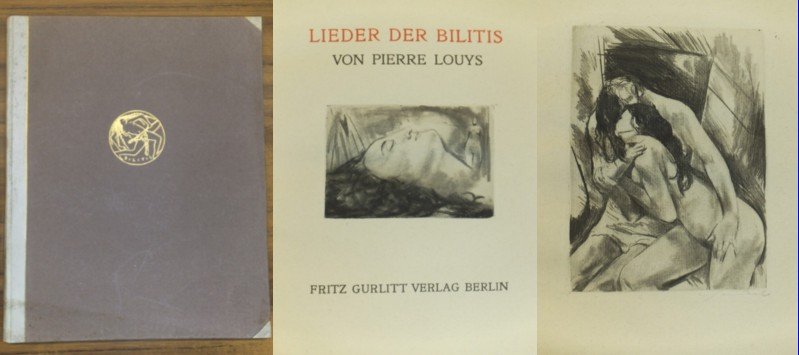


Joseph Kuhn-Régnier (1873-1940), was a French illustrator based in Paris. His work is easily recognisable because of the themes and figures he drew from Greek classical art; these often feature a black background and single colour figures inspired by Greek poetry, but he also designed full colour ‘Greek’ scenes that feature ancient dress and settings, but very modern looking and often saucy young women (see, for example, his Works of Hippocrates, 1934, which has clear sexual undertones). Kuhn-Régnier also contributed illustrations, caricatures and advertisements to magazines such as La Vie Parisienne, Fantasio and Le Sourire. In 1930 he designed twelve coloured plates for a further edition of Les Chansons de Bilitis. As will be seen, these are in the style he used for his humorous magazine illustrations (rather than his more austere classicist style), whilst remaining reasonably faithful to the text itself. That said, as may be observed below, the ages of Glottis and Kyse have been doubled by the artist, for reasons we can only speculate about.

.jpg)
In 1931 the Belgian artist Arthur Greuell illustrated an edition of Bilitis published in Brussels. His images of women are always marked by a severe profile and melancholy expression and the 35 plates for this version of the Chansons was no different, even for the poems celebrating the poetess’ love. Greuell’s women are, at the same time , muscular and energetic,


Pierre Lissac (1878-1955) worked as a painter, illustrator, engraver, cartoonist and caricaturist. He studied under Lefebvre at the Ecole des Beaux Arts in Paris and went on to work for humorous magazines such as Le Rire and La Vie Parisienne. He also designed adverts and illustrated books, especially for children, but his work on a 1932 edition of Bilitis is attractive for its bold colours and strong lines; once again, the artist has departed from the words of Louys’ text and Glottis and Kyse have become young women. For both Lissac and Kuhn-Régnier we might speculate about the reasons for this: a disapproval of this part of the book (but given its overall tone, why work on it if it was so inimical?); misinterpretation or carelessness, or a preference for drawing the nudes we have. As I observed in another post, illustration may reasonably be classed as a form of translation, but- even though we might think of images as an international means of communication- it should not be regarded as any more faithful or reliable than the transition from one language to another.

Nathan Iasevich Altman was born in 1889 in Vinnitsa in Ukraine and died in Leningrad in 1970; he trained as an artist in Odesa before travelling to Paris he to study and work between 1910 and 1914, developing a post-impressionist style. He was active producing revolutionary art in Russia after 1918 but by 1929 he was back in Paris, where he stayed until 1935, designing posters and illustrating books. One of these was the 1932 edition of Bilitis (the second that year, by mischance), for which he created pointilliste lithographs.

Andre-Edouard Marty (1882-1974) initially studied philosophy before travelling in Italy. Perhaps this experience awoke a love of art, for on his return he studied at the Ecole des Beaux Arts before becoming a humorous cartoonist, as well a designing posters, stage sets and fashion plates. His book illustration commissions included La Fontaine, Diderot, Musset, Maeterlinck and three works by Louys, the Poesies de Meleagre, Aphrodite (1936) and, in 1937, Bilitis. His style is noted for its stylised nature, especially the elongated and graceful figures, but it was very popular. His approach to Bilitis was suitably erotic (see below and his image of Bilitis in a tree, illustrated in my post on dryads).

A pause in new editions followed: initially the market was saturated, possibly, and then the war disrupted the fine art book trade (although the market for cheaper erotica persisted throughout the period). However, as soon as 1946, a new version of Bilitis appeared, this time illustrated by Albert Gaeng (1904-75). He was a Swiss artist who worked in a variety of media: glass painting, mosaic, oil painting, sculpture and murals. His training introduced him to cubism and futurism and, against this avantgarde background and with a strong interest in religious art, his illustrations for Louys may be something of a surprise. His drawings are pleasant without seeming hugely inspired.
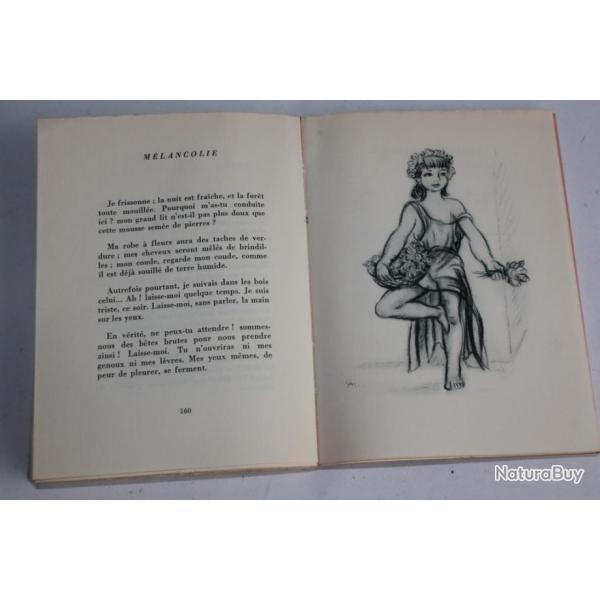
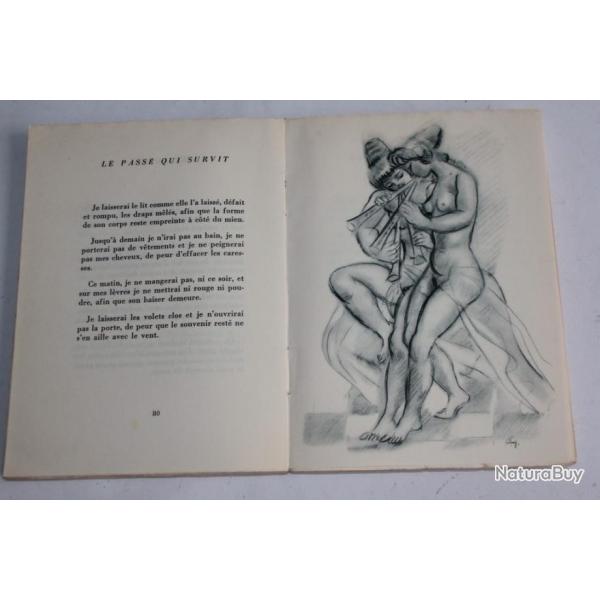
The next year Andre Agricol Michel (1900-72) was commissioned to work on another edition. Michel was born in Paris and studied at the Ecole des Beaux-Arts. He found work as a painter, printmaker, and illustrator and exhibited frequently. During the 1940s he became a set designer for the Paris Opera and became known for his drawings and prints of ballet. In addition to fine art, Michel was a prolific illustrator, creating works for a variety of publishers as well as publishing his own books of illustrations. Delicate line drawings accompanied the 1947 edition of Les Chansons de Bilitis, such as the illustration of Bilitis and Mnasidika seen below.

Andre Dignimont (1891-1965) was a very prolific artist and illustrator over four decades. Born in Paris, he studied at the College Juilly, worked for a time in London, and then returned to Paris to study at Academie Julian. Dignimont was primarily a pen and watercolour artist in the tradition of Jules Pascin and, like his good friend and predecessor, he was fascinated by the world of prostitutes, brothels, cafes, bars and Parisian nightlife. In addition to his paintings, he created theatre and opera designs, posters and illustrated over fifty books. Dignimont’s plates for the 1947 edition of Bilitis are highly typical of his style of topless young women, entirely appropriate to the subject and respecting the text itself. He also worked on Symbolist poet Paul Verlaine’s Oeuvres Libres in 1935.


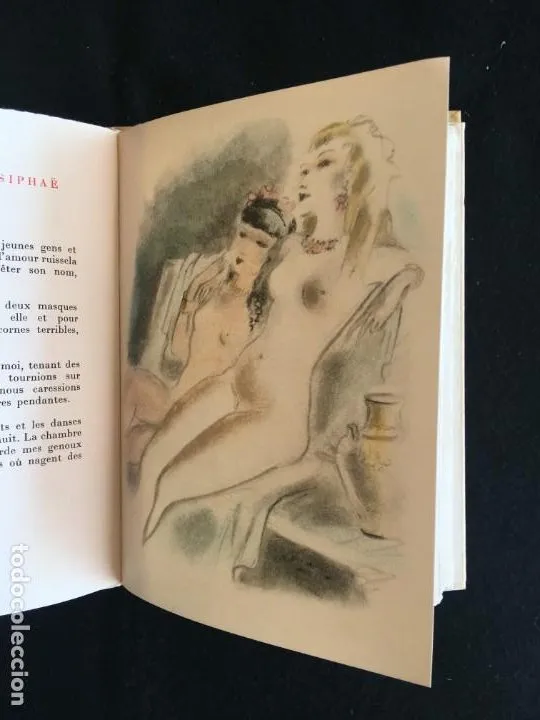
Maurice Leroy (1885-1973) was a painter, decorative artist and cartoonist, mainly known for his illustrative work in books and popular and humorous magazines; he also designed posters and postcards. Amongst the books he worked on are children’s stories as well as LaFontaine, Victor Hugo, Balzac and Voltaire. More significantly, he illustrated a 1947 edition of Baudelaire’s Fleurs du mal, Aristophanes’ Lysistrata and Les Quinzes joies de marriage (1941). His commission for a 1948 edition of Bilitis fits within these titles and the colour plates are faithful to the text- for example, his depiction of the opening scene of Bilitis in the tree and what I interpret to be the marriage of Bilitis and Mnasidika.
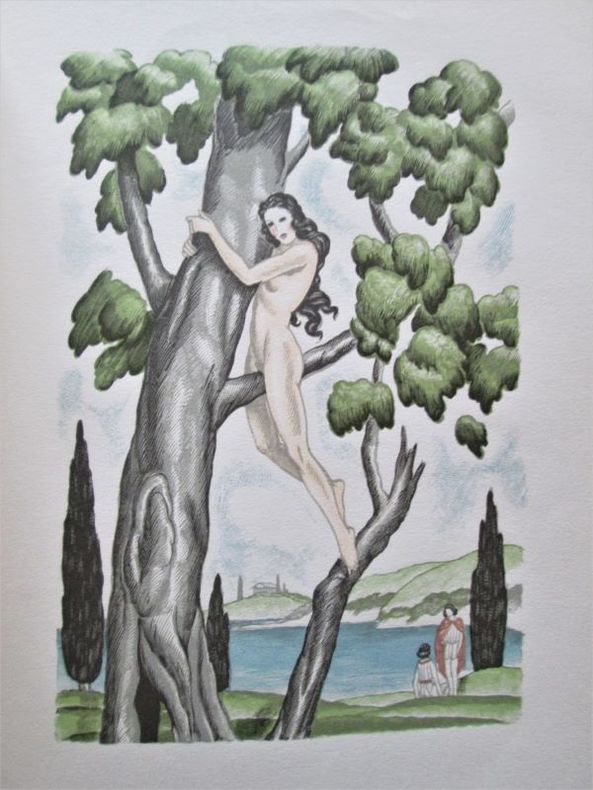
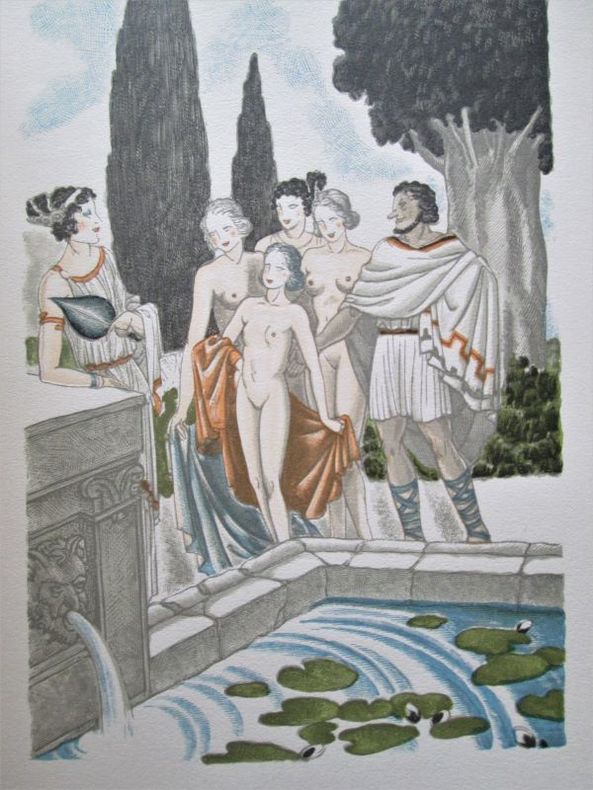
Mariette Lydis had been commissioned in 1934 to illustrate an edition of Bilitis as one of a set of Louys’ books being published by Union Latines D’Editions. In 1948 she was commissioned to tackle the text again, this time by the publisher Georges Guillot. Her twenty dry-point etchings are, of course, distinctively hers; they are variations on the images provided for the earlier edition, showing individual women and female lovers together.


Lastly, Pierre Leroy (1919-90) was an author, engraver and illustrator, much of whose work was on children’s books. His eighteen colour illustrations for the 1949 edition of Les Chansons are extremely attractive, but yet are frank renditions of the content.


What’s especially notable, I think, with many of the illustrators discussed here- and in the other related posts- is the frequency with which cartoonists and children’s artists were asked to work on the very adult Chansons de Bilitis. As I suggested in another recent post, I assume that their facility with combining text and image- and their ability to create an image that captured and concentrated the essence of a scene- was what recommended them to publishing houses. Lastly, of course, the abiding status of Pierre Louys’ first book- a classic based upon the classics- is brought out.
[…] new editions of the Songs issued after the end of the Second World War which I discuss in another post. The symbolism of Bilitis in the tree is also examined […]
LikeLike
[…] of writes such as Barney or Renée Vivien to express female-female desire. [The artist Marie] Laurencin became a part of this extended family [being] one of the many artists drawn to Barney’s orbit, […]
LikeLike
[…] with many of Louys’ books, a small flurry of new printings then followed. The major Swiss artist and writer […]
LikeLike
[…] the works by Pierre Louys that Ballivet illustrated are Les Chansons de Bilitis in 1943 and Le Roi Pausole in 1945. She also supplied erotic plates for an edition of Venus in Furs […]
LikeLike
[…] February 19, 2024 John's Art & Culture Blog literature, music, poetry, UncategorizedAphrodite, athenaeus, Bilitis, chansons de bilitis, Deipnosophistae, eupolis, flute, kordax, philetaerus, Pierre Louys Willy Pogany, from 1926 edition of Songs of Bilitis […]
LikeLike
[…] on a further edition of Aphrodite. He was also later to produce some striking illustrations to Les Chansons de Bilitis. His work on Louys’ second novel is characterised by its bold art deco style and beautiful […]
LikeLike
[…] lull until after the Second World war. However, as soon as 1945, an edition illustrated by Almery Lobel Riche appeared. He supplied twenty dry points, seeming especially intrigued by the story of Madame […]
LikeLike
[…] by William Godwin appeared, with colour illustrations by Jan de Bosschere, whom I featured before. Previously I reproduced the cover: here is one of the […]
LikeLike
[…] and colleague Otto Dix, an early target of the new regime. Dix’s art was regarded as ‘degenerate’ by the Nazis- his Venus in Black Gloves of 1932 may be the sort of challenging image that […]
LikeLike
[…] other examples I’ve noted previously include George Barbier, Louis Touchagues and Andre Dignimont. All of them surely deserve our respect for their multi-talented ability to turn their hands to […]
LikeLike
[…] Majeska (Psyche, 1928), Guily Joffrin (Psyche, 1972) and editions of Bilitis illustrated by Jeanne Mammen, Genia Minache (1950), Carola Andries (1962) and Monique Rouver (1967). The frequency with which […]
LikeLike
[…] and, in the tight knit artistic community of the French capital, he knew illustrators such as Andre Dignimont and Marcel […]
LikeLike
[…] In 1947 Edition du Grand-Chenes produced an edition of Bilitis illustrated with nine lithographs by Andre Dignimont. One thousand were printed, on velin blanc; the paper was very white and smooth, not as rich […]
LikeLike